Voicepipes have obvious advantages in naval warfare. They do not depend on electrical power, are immune to EMP, and will keep working after almost any amount of damage short of physical destruction. Such damage can of course occur, and was considered to be a contributory cause of the Russian defeat by the Japanese at the battle of Tsushima in May 1904.
There are snags of course; voicepipe communication between two water-tight compartments presents a clear risk of flooding, and requires shut-off valves to be fitted either side of the bulkhead, as you may not be able to get to one side of it...
 |
| Left: A voicepipe in the wheelhouse of the minehunter HMS Bronington.
This ship was completed in 1954 so voicepipes were clearly still current technology then. The pipe diameter seems to have increased over the WW2 version; or possibly the lagging is thicker.
|
 |
| Left: End fittings for voicepipes on the open deck.
The hinged covers keep out rain and spray. The location of the other end of the pipe is indicated on the brass plate in the middle of the flap.
|
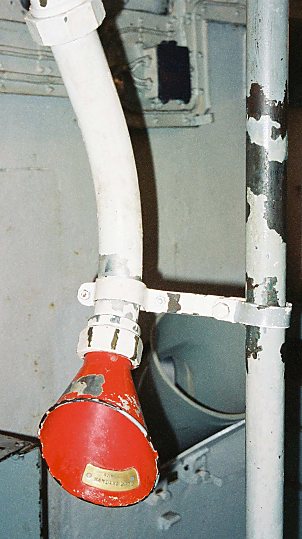 |
| Left: A voicepipe in one of the forward gun turrets of HMS Belfast.
HMS Belfast is a WW2 cruiser preserved and moored just above Tower Bridge, in London. The brass plate reads "Handing Room" which appears to be a misprint for "Handling room" ie the shell handling room below the gun turret. However, some correspondents have told me that "Handing Room" is in fact correct.
The pipe is of 2-inch diameter, and has no lagging on it.
|
Noted in the Scientific American Supplement for May 1897:
"A form of speaking tube for use of steamers has recently been introduced in England. The pecularity of it lies in the fact that the pipe is insulated from the body of the ship by a covering of waterproof textile material. This latter, being a very bad conductor of sound, enables long lengths of tube to be used without rendering the speech transmitted inaudible at the far end. The distance from the bridge to the engine room on the steamer India is over 300 feet, yet even with the engines running it is possible to hear clearly in the engine room, through the tube there fitted, orders given on the bridge. An electric call is fitted, as the ordinary whistle cannot be used for so long a length of pipe."
This appears to explain the white lagging on the voicepipes shown above; it was to reduce acoustic interference.
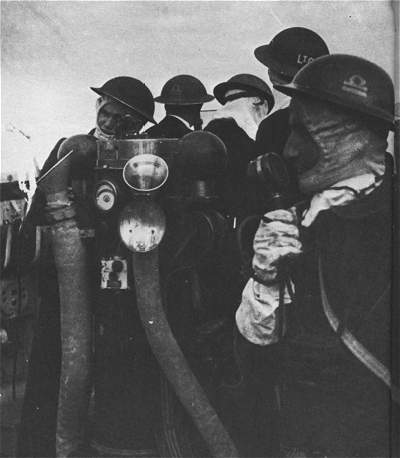 |
| Left: Voicepipes in action. This is the compass platform of a British ship (probably a cruiser) in action during the Second World War.
Voicepipes with their covers open can be seen grouped around the compass, with its two large compensating spheres.
The man on the right holding the microphone is the Torpedo Officer, who is giving the ship's company a running commentary through the ship's PA system, which was of course electrical.
Everyone is wearing anti-flash gear in addition to their steel helmets.
|
My correspondent, known to me only as "Joe Schumckitelli" writes:
"I was in the US Navy for 4 years as in Interior Communications Electrician. The voice pipes fell under my responsibility for maintainence and repair (among other things). Conveniently, the voice pipes never needed either maintainence or repair, as they were never used because electronic communication devices were much more audible. Even during a power failure, sound powered telephones were used. The voice pipes were designated circuit "Y," or "CKT Y." All communications circuits, both electrical and non-electrical had circuit names."

This extract comes from the US Naval document "General Specifications- Appendix 10" (1936) which describes the Nomenclature of decks, Numbering of watertight compartments and Labeling on US vessels:
"Voice tube numbers shall be assigned serially in accordance with the voice tube list, each number bearing the prefix "VT" instead of the composite number above described. Each voice tube shall be labeled at least once in each compartment through which it passes, with a tag permanently secured to the tube in such a manner that the tube can be readily identified. At the outlets, labels shall be fitted both on the inside and outside of the cover, so that the tube number and the station to which the voice tube leads will be clearly shown at all times. Where such label plates may be installed close to and above the mouthpiece in such a manner that the voice tube can be readily identified whether open or shut, it will not be necessary to install labels on the cover proper."

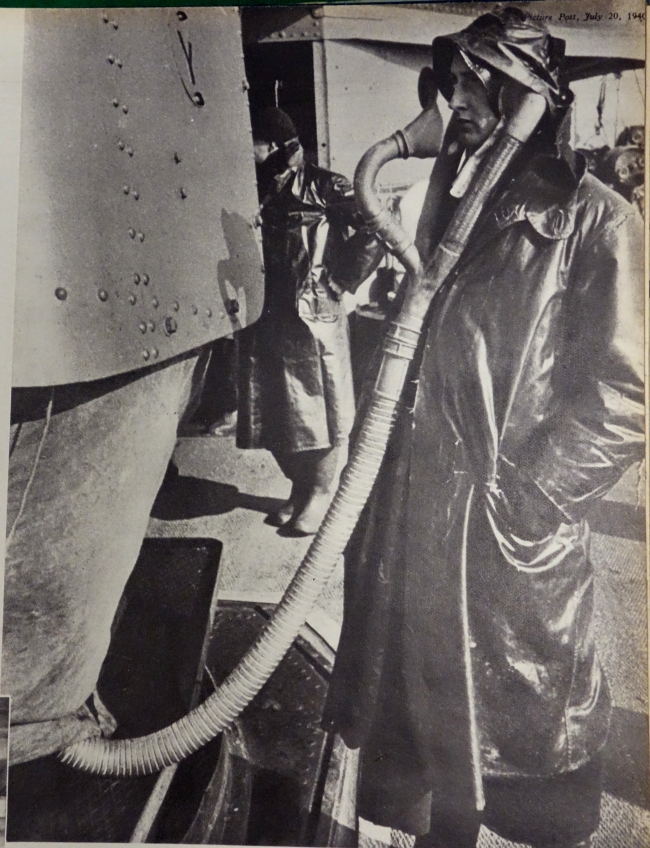 |
| Left: Unusual forked voicepipes on a destroyer: 1940
This image comes from Picture Post 20th July 1940, which was just after the evacuation of Dunkirk. (27 May to 4 June)
According to the text, this man passed orders from gunnery control to a gun crew, using this bizarre three-way voicepipe. If this was correct, his career was likely to be short as he appears to standing on the unprotected deck, rather than inside the shelter of a gun mounting. The antiquated look of it all causes me to suspect that the picture was released in an attempt to deceive the enemy into thinking that British gunnery control was much more primitive than it really was.
|

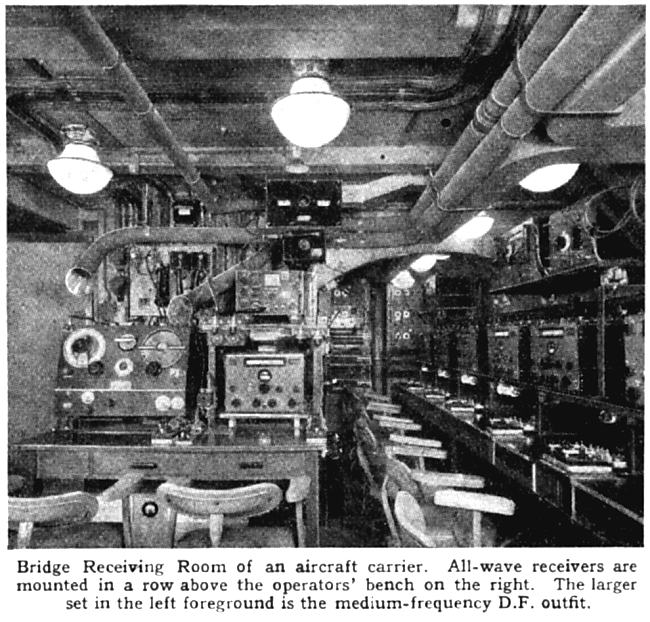 |
| Left: Voicepipes on an aircraft carrier: 1947
The mouths of two voice pipes can be seen to the left just above the medium-frequency DF (Direction-Finding) set. The pipes can be seen running horizontally and then up to the right.
From Wireless World Feb 1947
|
 |
| Left: Voicepipes on the bridge of HMS Cavalier at Chatham
At Chatham Dockyard, there is preserved the WW2 destroyer HMS Cavalier, which has a fine set of voicepipes. Here are two on the bridge, looking forward. The captain's high chair is just to the right of the edge of the photograph. IIRC correctly, the pedestal in the middle carried a compass repeater. The brass plate carries a table relating speed in knots to shaft revolutions.
An interesting issue is the markedly different diameter of the two voicepipe tubes, one being almost twice the diameter of the other. Was the wide tube going a longer distance and so had to have less attenuation? There are no labels on the voicepipe mouths, and the hinged covers appear to be missing.
Author's photograph.
|
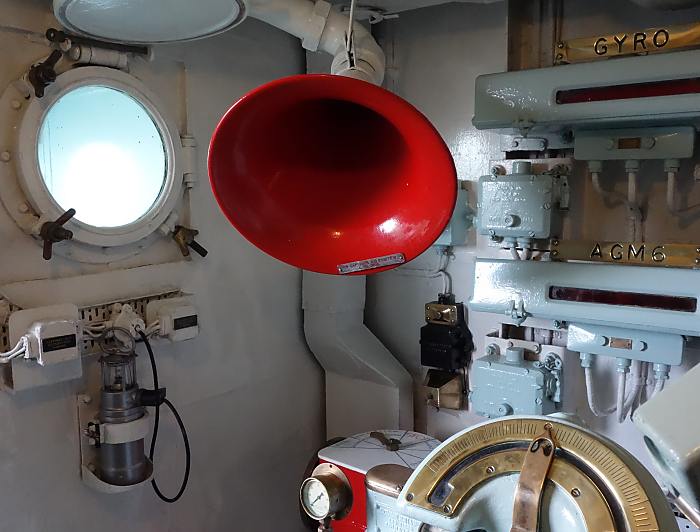 |
| Left: Voicepipe horn on HMS Cavalier
The steering position of HMS Cavalier, with a very large horn for receiving helm orders. The label on it says "CAPTAIN'S A/C POSITION AND PELORUS." I don't know what "A/C" means here, but a pelorus is a simple instrument for taking relative bearings, usually found on the bridge. The ship's wheel is just below the brass rudder indicator at bottom right.
Author's photograph.
|
 |
| Left: Not a voicepipe on HMS Cavalier
This piece of equipment is to be found on the port side of the bridge of HMS Cavalier. It is not a voicepipe, but a device for peeing in. The exit pipe leads down and over the ship's side, and the valve above is for flushing it.
"Ceci n'est pas une voicepipe" as Magritte might have said.
Author's photograph.
|
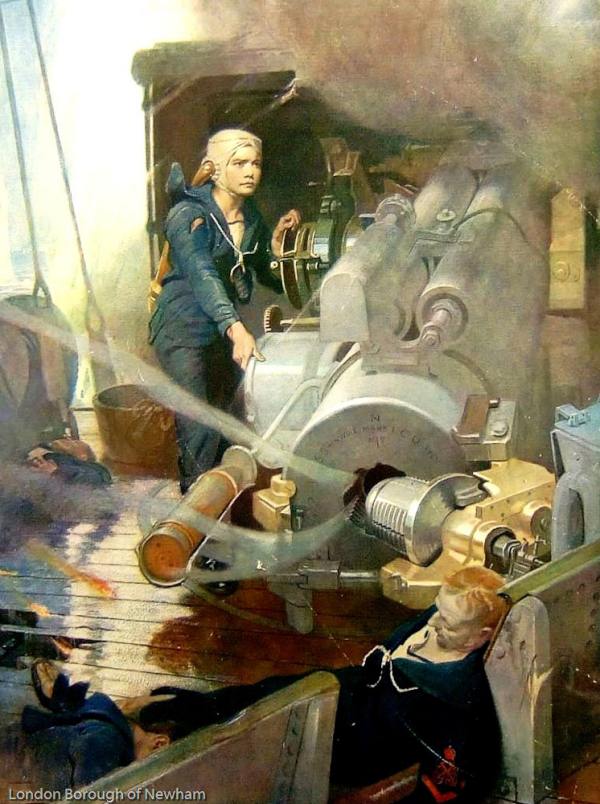 |
| Left: Jack Cornwell with acoustic headphones
This is probably the most famous painting that includes voicepipe technology. It depicts Jack Cornwell, a local hero round my way. At the Battle of Jutland the shielded 5.5-inch gun mounting on the Chester where Cornwell was serving as a sight-setter was affected by at least four nearby hits. The 5.5-inch guns were the secondary armament, and the mountings were open-backed shields and did not reach the deck. All of the gun crew were killed except Cornwell who, although severely wounded, managed to stand back up, and although the entire gun crew around him dead or wounded, he remained standing at his post for more than 15 minutes until Chester retired from battle with only one main gun still working. He died two days later at Grimsby General Hospital. He was posthumously awarded the Victoria Cross, and became a national hero.
Cornwell is wearing a helmet with acoustic tubes running to it, through which sighting instructions were passed. Note the heavy-looking pipe running down his back. Presumably he could talk back to confirm orders; there is something hanging round his neck on a white cord that might be the mouth of a voicepipe. I think we can have confidence in these technical details because the artist has rendered the gun mounting (which is preserved in the Imperial War Museum) with great accuracy.
There are at least two other pictures showing Cornwell wearing electric headphones and a horn microphone on his chest, but both of these render the gun inaccurately, and so are not to be trusted.
This picture was painted by Frank O Salisbury RI ROI RP, a British artist who lived 1874-1962. A large preparatory painting for this work was sold at auction for £22,500 in 2014.
|
I have always had faint reservations about this story. While Cornwell may have displayed some true grit in standing up rather than laying down, this actually helped nobody. The rest of the gun crew was dead or disabled and there was no possibility of getting the gun into action again. At the time the Battle of Jutland was seen by the British as at best a draw, (though in fact the German fleet never troubled us again, so it was really a win) and it was no doubt thought that a boy hero would be just the thing to raise public morale.

SUBMARINE VOICEPIPES
Voicepipes were used in submarines, much as they were in surface ships. The picture below shows a conventional surface-type voicepipe at the steering position of HMS Ocelot, an Oberon-class submarine preserved at Chatham Dockyard.
 |
|
Above: Voicepipe at the steering position of HMS Ocelot: Author's photograph 2015
I assume that the other end is at the captain's position in the control room, but it was a pretty rapid guided tour and I did not have time to locate it. The box immediately to the right of the voicepipe is labelled "ACTION INTERCOMM LOUDSPEAKER" and would have been the normal means of communication.
|
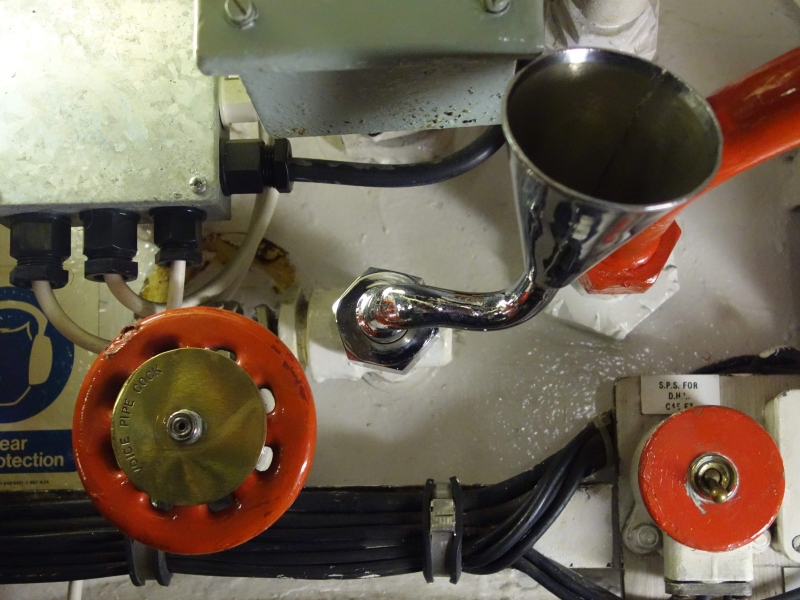 |
|
Above: Inter-compartment voicepipe on HMS Ocelot: Author's photograph 2015
Now this is undoubtedly a most frightening voicepipe. It is intended for use between two compartments of the submarine when the water-tight door between them is closed. The red valve at lower right shuts off the pipe if the next compartment is filled with water; there is an identical valve on the other side of the bulkhead. The unit is mounted well above the top of the water-tight door.
It is easy to imagine that the messages passed through these voicepipes were not likely to be happy ones. But in fact, no Oberon-class submarine was ever lost at sea, though the Brazilians did manage to sink an Oberon they had bought new, the Tonelero, while she was docked at the navy yards at Rio de Janeiro. On Christmas Eve 2000, she sank at her mooring due to crew error. All 9 crew members aboard escaped. The boat was refloated, but has since been decommissioned.
|

TERRESTRIAL VOICEPIPES & SPEAKING TUBES
As a general rule "voicepipe" is a maritime term, and those on land were usually called "speaking-tubes". A normal installation had a removable whistle plugged into each end. To initiate a conversation Person A removed his whistle and blew down the tube, sounding the whistle at the other end. Person B then removed his whistle, and talking could begin. Hence the expression, still current in Britain, "I'll get him on the blower" when a telephone call is meant.
Such systems appear to have been quite common in homes and offices, though very little information about them, and very few references to them, seem to remain today.
I have secured one passage about speaking tubes from the memoirs of Sir Aylmer Firebrace, CBE, who was Chief of the Fire Service 1941-47:
"Internal house telephones were a long time coming in; speaking tubes were used instead. They were still in place- and some were in daily use- when I joined. The vicinity of the Chief Officer's desk literally bristled with speaking tubes, whilst the quarters provided for me, formerly the top two floors of Massey Shaw's house, had a voice pipe in every room, including bathrooms. They were in general use at fire stations; the modern expression "Give me a ring" was in those days, "Get me on the blower." The duty man (man on duty in the watch room) would gain the officer's attention by blowing up the tube to his quarters and so operating the removable whistle inserted in the end."
One of the very few firm statements on performance I have been able to find comes from "Manufacturer and Builder" for Mar 1872: "Two persons standing at each end of a simple tin pipe, 1 inch in diameter, 50 to 100 feet or more long, with several elbows in it, and carried through a half a dozen rooms, can still converse quite readily in a low voice."
Terrestrial speaking tubes had a smaller diameter than the sea-going version, with diameters from 15 to 25mm being quoted. This smaller diameter was easier to conceal in walls and under floors, but would given more volume loss. This was tolerable for short pipe runs in a relatively quiet environment. Shipboard voicepipes, in contrast, had longer pipe runs, and had to compete with the noise of machinery and weather; this is probably why they were larger in diameter.
The acoustic losses in a tube are due to viscous friction between the vibrating air and the walls of the tube. Thus a bigger tube gives lower losses, as on doubling the diameter, the wall area for a given length is also doubled, but the mass of air in that length is quadrupled.
In fact the loss in dB is inversely proportional to the area, and hence to the diameter squared. The theoretical attenuation of a 5-cm (2-inch) diameter voicepipe is 30 dB per 100 metres.
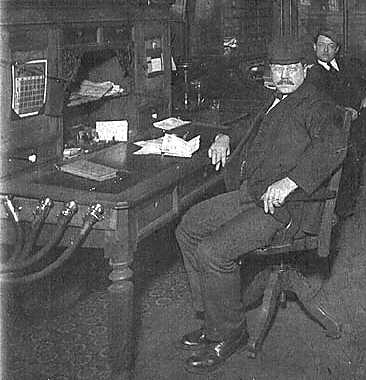 |
| Left: An office in 1903. There are four flexible speaking-tubes hooked on the end of the table.
The elliptical funnel shape of the mouthpiece on each tube is presumably to make it easier to blow down the tube to activate the calling whistle at the far end.
|
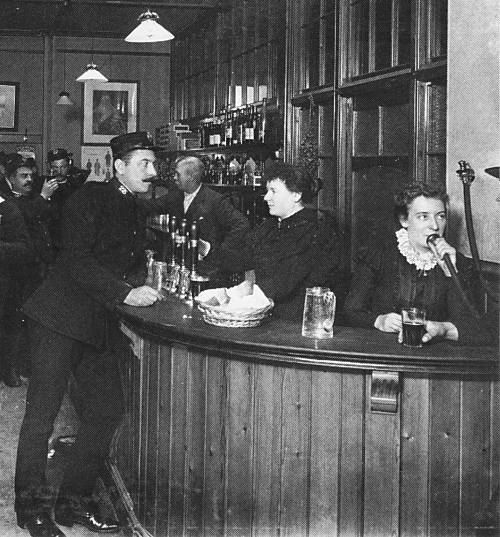 |
| Left: A speaking-tube in use in a bar: date unknown
This deeply obscure photograph shows the bar of the Old Barracks, one-time headquarters of the Corps of Commissionaires. The lady on the right is using a speaking-tube, presumably to talk to the kitchen; however she only has eyes for the enigmatic gent at extreme right. The Old Barracks was in Exchange Court, just off the Strand in London. The date is probably in the 1880's.
From "Our Sergeant: The Story of the Corps of Commissionaires" by Peter Reese
|
 |
| Left: A cartoon featuring an automotive speaking-tube.
Images of car and aeroplane voicepipes have proved very hard to come by. The best I can do so far is this cartoon, published in Lilliput* for October 1946; the lady in the back is presumably supposed to be playing a trumpet solo on the voicepipe, to the displeasure of her chauffeur. Such devices were clearly not wholly obsolete then, as the cartoonist assumed his audience would know what he was depictng.
The horn at the driver's end is placed handily by his ear, but it is not obvious how he could reply without turning his head and taking his eyes off the road. Some sort of response was presumably expected, if only "Yus, m'lady"
* Lilliput was a pocket-sized magazine published during and after the Second World War in Britain.
|
I received this email from Mr Vincent Griffin on 11th April 2008, and I reproduce it here (with permission) as it gives some insight into domestic speaking tubes, and in the hope that someone may be able to answer his query. If so, please contact me.
My wife and I have a Victorian house that was built in 1895 and for the
past two years we've been in the process of rehabbing it. During the
course of demo in the kitchen we found the remnants of the old
speaking tube system that ran from the kitchen up to the 2nd floor
hall. The tubes were intact but the mouthpiece openings had been
patched over and the mouthpieces were nowhere to be found.
I have looked far and wide trying to locate some replacement
mouthpieces and have come up empty-handed. We were wondering if you
know of any companies and/or salvage yards that might possess parts
for our system? Your help would be greatly appreciated.
I've included a pic of what I believe was originally installed in my
house. The mouth piece has no electric parts. It operates by means
of using the thumb to rotate the lever (in order to move the disc out
of the way) and then blowing into the tube. The other end also has a
disc that acts as a whistle to alert the person on the other end that
someone wishes to speak on the "intercom". I think that the
mouthpieces were made out of nickel-plated brass and/or porcelain.
I appreciate any help that you could give me.
Vince Griffin
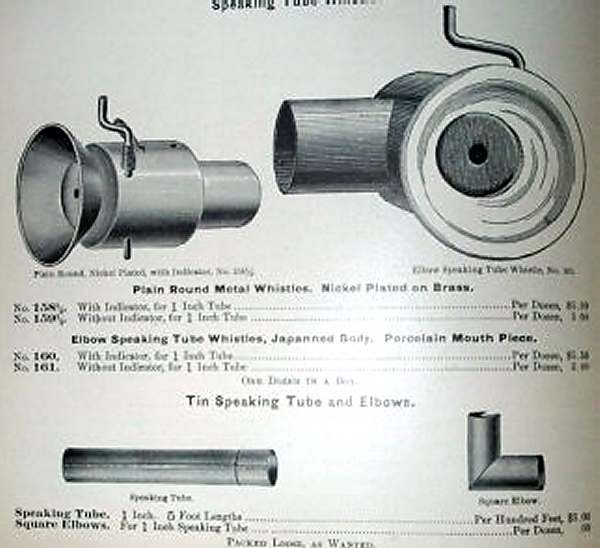 |
| Left: The picture that Vincent Griffin sent.
The lever on top moves aside the disc containing the whistle to allow blowing or talking.
The mouthpieces could be ordered "with indicator". This is pure speculation, but I assume it was some sort of pressure operated flag that gave a persistent indication that a particular pipe had been blown. If you were sitting in the servant's hall faced with half-a-dozen speaking tubes connected to various parts of a large house, that could have been very useful.
|
Good grief, you can still buy these things! See diytools.co.uk (external link) for a speaking tube that communicates with visitors at the front door.
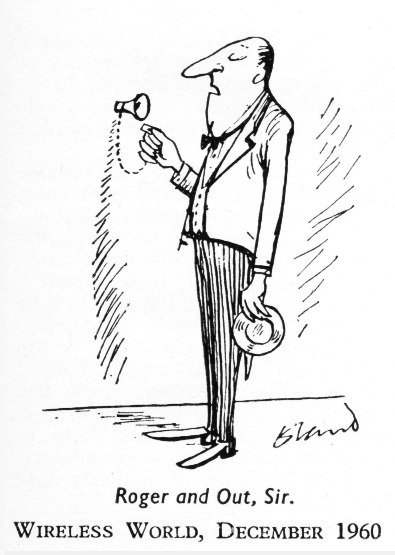 |
| Left: Voicepipe cartoon in Wireless World: 1960
Demonstrating that voicepipes were still familiar things in 1960. The butler is holding the call whistle in his right hand.
From the December 1960 issue of Wireless World, once an influential journal on radio and electronics.
|
Here is a 1949 memoir recalling R J Ransome, a director of Ransomes & Rapier in Ipswich, in the 1880's:
"R J Ransome... would not attend conferences, but conferences might come to him- speaking tubes were available to the Secretary and Works Manager, and instructions to the lesser fry were circulated by notes..."

AIRBORNE SPEAKING TUBES.
The Gosport speaking-tube system was intended to provide communication between an instructor and a trainee pilot, usually in a Tiger Moth. It was invented by flying instructor Robert Smith-Barry at the School of Special Flying he opened at Gosport in 1917; he had tried conventional single-tube speaking tubes and electrical apparatus but neither were audible above the engine noise. The double-listening tube approach was however an immediate success. The first test took place over the Solent on 20th June 1917 and the equipment was immediately put in to use. It remained the principal communicating device for teaching flying until the 1950s.
 |
| Left: Avro Tutor cockpit with Gosport speaking tube: 1930s
The mothpiece of the Gosport system can be seen to the extreme right next to the temperature gauge.
The Avro Tutor was a highly sucessful two-seat British radial-engined biplane in use from 1930 to 1941. It was a simple and rugged initial trainer noted fot its good handling. It was mostly used by the Royal Air Force but also adopted by many other countries, including Canada, Poland, and South Africa.
|
"Both cockpits had a flexible pipe which emerged from behind the instrument panel and terminated in a rubber mouthpiece. As these became aged they could be relied upon to blacken the face of the user so that at the end of a busy day's flying the instructors looked as though they had been down a coal mine. Particulary during takeoff and landing it was essential that the speaking tube should remain in the position set by the instructor, since both hands were on the controls and he was unable to support the mouthpiece. With constant use much of the rigidity would disappear from the speaking tubes and they would droop like jaded flowers and have to be tied up with string. It was almost always necessary to speak slowly, deliberately, and above all loudly, and on occasions when moisture collected in the system it was almost impossible to hear."
From The Tiger Moth Story by Alan Bramson & Neville Birch
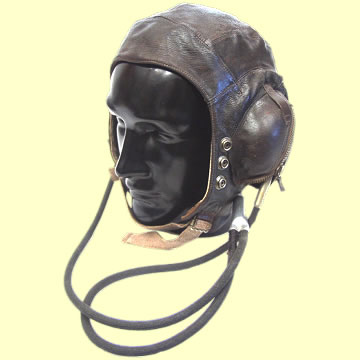 |
| Left: Unidentified flying helmet with Gosport speaking tubes
|
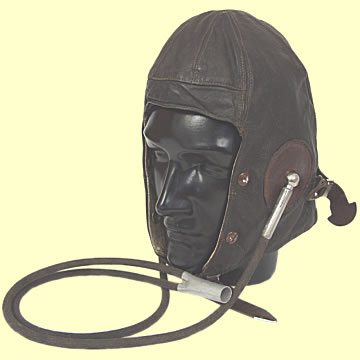 |
| Left: RAF type-B helmet with Gosport speaking tubes
|
It appears that some Japanese aeroplanes in WW2 were fitted with voicepipes for inter-crew communication; see www.historyplace.com (external link)
A short extract from that link:
"In the midst of this chaos, as our plane dodged enemy fire, a small but significant mishap occurred. "The machine gun! I can't fire it! There's a cartridge jammed in the magazine!" Tanaka screamed through the speaking tube."
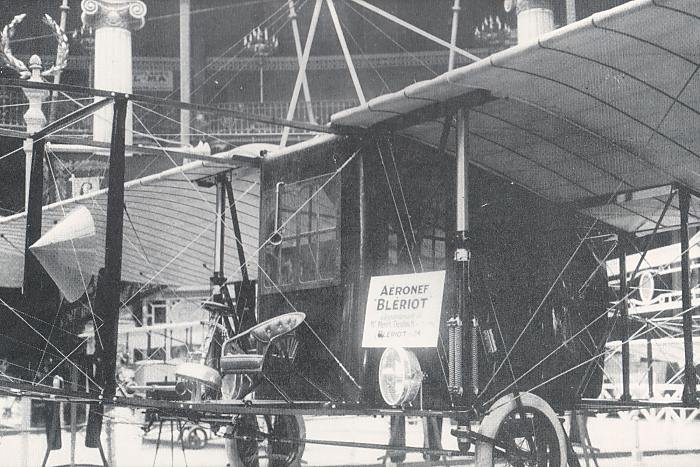 |
| Left: A Bleriot "Aero Taxi" in 1910
Note the voicepipe to the left of the window, for communication with the pilot.
This rather unlikely-looking aircraft appears in the book "This Was Air Travel" by Henry R Palmer. (Bonanza,
pub 1957) It is a Bleriot "Aero Taxi", powered by a 14-cylinder 100 hp Gnome Rotary driving a pusher propller. It did fly but was not an economic success. The flat-fronted cabin must have created enormous drag, not much improved by the cone-shaped thing in front of the driver, which I assume was meant to be an air-deflector. It appears to be on display at an aircraft show, probably the 2nd Paris air show at the Grand Palais.
|
 |
| Left: Bleriot "Aero Taxi" voicepipe: 1910
A close-up of the voicepipe.
An article on the aeroplane in Flight (25 Nov 1911) said: "To facilitate communication between passengers and pilot, a speaking tube, similar to those in use on taxis, is fitted."
|
I have just been sent this story by Mr Marcus de Mowbray:
Have just been having one of my many browses on your superb site and
was looking at the Voice pipes and Speaking Tubes and noticed them in
the photo of the Avro Tutor and you might be amused by this novel use
of a speaking tube....
My father was a trainee Observer/Navigator in the Fleet Air Arm
towards the end of WW2, flying in Swordfish, Albacore, Baracuda and
various other planes. His favourite and most regular pilot was
completely beyond discipline and always keen on having fun.
One time at night at sea in freezing winter weather he told the pilot
to change course, using the speaking tube and its other end in the
pilot's helmet. The pilot disobeyed and carried on having fun and
going wherever he wanted.
After two more ignored orders Dad was very concerned about getting
lost and having to ditch, so in desperation he held the mouth-piece out
into the freezing air stream,so the pilot got jets of freezing air
blasted straight into his ears. Dad's only other comment about the
incident was "He never disobeyed me again".
The pilot was eventually "released" from service because it was felt
he could "... do more for the War Effort making patriotic films than
by bending any more valuable aircraft"; he was Laurence Olivier.
Wikipedia has this to say:
"When the Second World War broke out in 1939, Olivier intended to join the Royal Air Force, but was still contractually obliged to other parties.[3] He took flying lessons, and racked up over 200 hours. After two years of service, he rose to the rank of Lieutenant Olivier RNVR, as a pilot in the Fleet Air Arm,[32] but was never called to see action.... In 1944, Olivier and fellow actor Ralph Richardson were released from their naval commitments to form a new Old Vic Theatre Company."

FICTIONAL SPEAKING TUBES
In Terry Pratchett's Discworld series, speaking tubes appear now and then. The Watch have them installed at their headquarters, as well as pneumatic message tubes. The inevitable occurs, as detailed in The Truth:
He unhooked a speaking tube from a brass and leather construction on his desk and hesitated.
'Have they got that problem sorted out, sergeant?' he said, ignoring William.
'Yes, sir. The pneumatic message system and the speaking tubes are definitely separated now.'
'Are you sure? You do know Constable Keenside had all his teeth knocked out yesterday?'
'They say it can't happen again, sir.'
'Well, obviously it can't. He hasn't got any more teeth. Oh, well...' Vimes picked up the tube, held it away from him for a moment and then spoke into it.
'Put me through to the cells, will you?'
'Wizzip? Wipwipwip?'
'Say again?'
'Sneedle flipsock?'
'This is Vimes!'
'Scitscrit?'
Vimes put the tube back on its cradle and stared at Sergeant Angua.
'They're still working on it, sir,' she said. 'They say rats have been nibbling at the tubes.'
'Rats?'
'I'm afraid so, sir.'
|
I hope that comes within the bounds of fair quotation. I am a great admirer of Mr Pratchett.
Also, in The Hogfather Lord Downey uses a speaking tube.






































